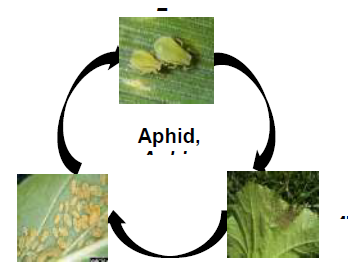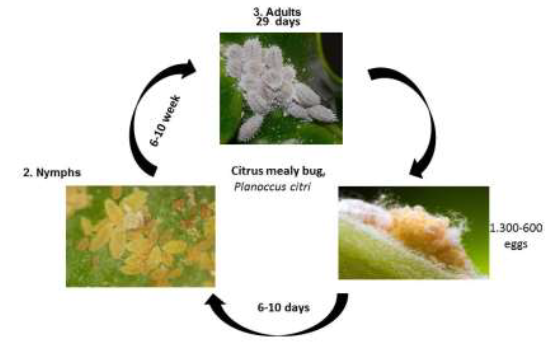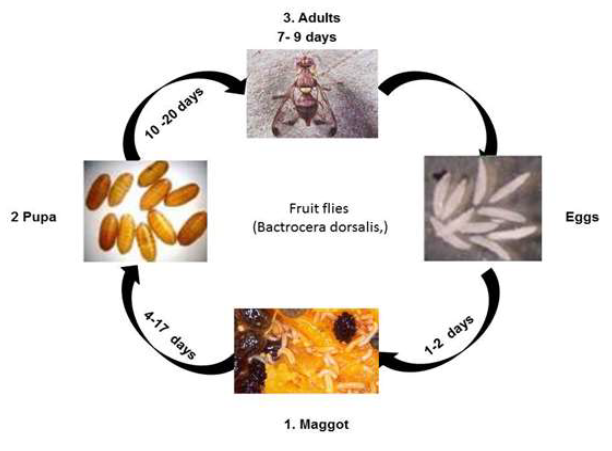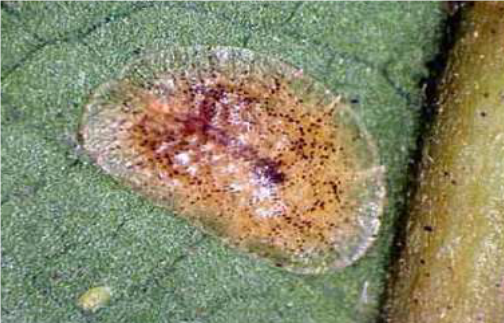Passion Fruit Insect and Mite Pests
Aphid
Biology:- Both winged and wingless forms breed parthenogenetically.
- Aphids reproduce in two ways: by laying eggs and giving birth to young ones. Which birth process is used depends on environmental conditions and the availability of food.
- When food is plentiful, aphids give birth to live young. Populations develop quickly as this pest has many young ones, a short lifespan and pre-adult insects can also give birth.
- Eggs hatch after three or four days. Young aphids, called nymphs, need five to eight days to become adults.
- It has 12-14 generations per year
Life cycle:

Damage symptoms
- Aphids cause malformation in foliage, and they are more important as disease vectors.
- Myzus persicae and A. gossypii transmit viral disease that causes hardening of fruits.
- Myzus persicae and M. solanifolii are vectors of the passion fruit woodiness virus.
- Predators: Scymnus, Chrysoperla, Aphidoletes, Syrphus Coccinellids etc.
- Parasitoids: Lysiphlebus testaceipes, Aphidius colemani, Diaeretiella rapae
Mealybugs
Citrus mealy bug, P. citri, is a small, oval- shaped sucking insect commonly found on passion fruit. Mealybugs characteristically aggregate on the plant, especially at leaf nodes and under dead leaves and trash. Aggregation may also occur under dried flower bracts. Secretion of a sugary solution from the mealy bugs promotes growth of a black fungal mould on the fruits and leaves.
Biology:- Eggs: Eggs are deposited as white cottony masses called ovisacs on trunk and stems of citrus plants, giving the appearance of cotton spread on plants. The glossy, light yellow eggs are oval and approximately 0.3 mm long. A female can lay from 300 to 600 eggs in her life period, which are deposited in groups of 5 to 20. Depending on the season, egg hatch may occur after 6 - 10 days or several weeks. An average of 29 eggs per day is laid by females.
- Nymphs: Nymphs emerge from the ovisacs and typically settle along midribs and veins on the underside of leaves, young twigs, and fruit buttons. Wax and honeydew secreted by crawlers are visible indicators of infestations. First instar female and male nymphs are called crawlers. The nymphs take 6 to 10 weeks to reach maturity. The nymphs are yellow, oval-shaped with red eyes, and covered with white waxy particles The female nymphs resemble the adult female in appearance, while male nymphs are more elongated. Female nymphs have four instars. Males differ greatly; they have three instars and a pre-pupal stage.
- Adult: Adult size ranges in length from 3 mm (females) to 4.5 mm (males). The females are wingless, white to light brown in color, with brown legs and antennae. The body of adult females is coated with white wax and bears a characteristic faint gray stripe along their dorsal side. Short waxy filaments can be seen around the margins of their oval body with a slightly longer pair of filaments present at the rear end of their body. Female mealybugs are wingless and, therefore, must be transported to subsequent host plants, although they are able to crawl for short distances. The immature can be blown by wind. Females can live for up to 29 days depending on the host plant. Males are similar in color to females and have two long backward-projecting white wax threads.
Life cycle:

Damage symptoms:
If a severe infestation occurs, loss of vigour, leaf drop, and fruit malformation may occur. Unchecked, an infestation may cause death of the plant.
Natural enemies of Mealy bug:- Predators: Cryptolaemus montrouzieri, Harmonia octomaculata, Lacewing larvae
- Parasitoids: Coccophagus sp., Anagyrus coccidivorus, A. pseudococci, Leptomastidea abnormis, Leptomatrix dactylopii
Fruit fly
Biology:- Egg: Female flies insert eggs under the skin of fruit in clusters of 10 to 50 about 1/25 to 1/8 inch below the fruit surface. The eggs measure about 1/25 by 1/250 inch and are white, elongate, and elliptical. They hatch in 1-1/2 days.
- Maggot: The white maggot is legless, and resembles an elongated cone. The mouth is at the pointed end of the body. There are 3 larval stages, or instars. The third instar is about 2/5 inch long. The entire maggot stage lasts for 11-15 days.
- Pupae: When mature, maggot drop to the ground and pupate in the soil. The puparium is yellowish-brown and seed-like. Adults emerge in about 10 days.
- Adults: Generally, the abdomen has two horizontal black stripes and a longitudinal median stripe extending from the base of the third segment to the apex of the abdomen. These markings may form a "T" shaped pattern, but the pattern varies considerably. Females begin to lay eggs about 8 days after emergence from the puparium. Under optimum conditions, a female can lay more than 3,000 eggs during her lifetime, but under orchard conditions approximately 1,200 to 1,500 eggs per female is considered to be the usual production. Ripe fruit are preferred for egg laying, but immature ones may be also attacked.
Life cycle:

Damage symptoms:
- Fly species feed upon the fruits of Passiflora spp., and also attack flowering buds.
- Fruit fly adult damage is caused by oviposition in green fruits, causing disfigurations of the fruit surface.
- The larvae damage the fruit by feeding on its pulp, contaminating it with bacteria and fungi and causing premature fruit drop. The oriental, melon, and Mediterranean fruit flies puncture the fruit while the rind is still tender.
- If the fruit is small and undeveloped, the damage may be sufficient to cause it to shrivel and fall from the plant. If the fruit is well developed, it may continue to maturity.
- Infested immature fruit shows characteristic skin blemishes. A few days after larval infestation, mature fruit will show wrinkling and breakdown.
Parasitoids: Opius fletcheri
Scales:
Biology:- Females are viviparous.
- Eggs hatch just before being laid.

- Females produce 60 to 150 nymphs over a ten-day period. After a brief period of quiescence (2 to 4 hours), the nymphs leave the maternal scale and disperse on the host tree, preferably onto stems, but also onto foliage and fruits.
- The majority have settled one day later. Reproduction is greatest during uniformly hot and dry conditions. Summer heat, combined with even slight humidity, causes considerable mortality amongst newly emerged nymphs under the maternal scale.
- The imaginal moult usually occurs 5to 6 weeks after egg hatching.
- Soft scales and diaspidids injure plants by sucking sap, and when in numerous can kill the plant.
- They sometimes heavily encrust the leaves, fruits, twigs or branches.
- Parasitoids: Aphytis spp.
- Predators: Ladybird beetle
Mites
Biology:- Eggs: Eggs are deposited singly, in cracks, crevices, and other protected areas on the plant surface. These clusters of bright reddish orange eggs. Eggs have a stipe, a tail-like projection, that extends from the slightly pointed end that came out of the female mite last. This stipe often breaks off if the egg is handled. A day before hatching, the eggs become opaque white and the red eyes of the larvae are visible within.
- Larvae: Larvae are six-legged, bright orange-red when newly emerged, but turn an opaque orange when fully grown. Nymphs: There are two nymphal stages, the protonymph and the deutonymph. The protonymph is larger than the larva and has eight legs. The outer shell is transparent; light green, orange, black, and yellow patches may be seen within the body. The deutonymph is similar in appearance to the protonymph except for having an extra pair of legs, two additional setae (hairs), and being slightly larger.
- Adults: Adult females are about 275 microns long, including the rostrum. The body is flat, light to dark green or reddish orange. Two pairs of legs extend forward and two pairs extend behind. The adult male is flat, reddish and more wedge-shaped than the female. Males do not have black markings. On average, adults lived for a maximum of 47 days at 68°F and a minimum of 7.5 days at 86°F with a relative humidity of 85 to 90 percent. Duration from egg hatch to adult required a minimum of 10.6 days at 86°F and a maximum of 27.3 days at 68°F.

- Mites are scattered in reddish patches on the surface of the fruit, particularly around the stem end, along the midrib and veins of the leaf, especially on the under-surface.
- Brevipalpus phoenicis is responsible for general discoloration of the leaves, and necrosis, culminating in leaf drop.
- Attacked young stems dry from the extremity to the base and eventually die. With heavy and prolonged infestation, leaf fall increases and the vine has the appearance of dying back.
- At the same time, developing fruit may begin to shrivel and fall prematurely from the plant. If red spider mites are left uncontrolled, the plant may eventually die.
- Dense populations of spider mites produce silken webs that cover the leaves. Heavy infestations cause leaves to drop and plants to lose vigour.
Predators: Anthocorid bugs (Orius spp.), mirid bugs, syrphid/hover flies, green lacewings (Mallada basalis and Chrysoperla sp.), predatory mites (Amblyseius alstoniae, A. womersleyi, A. fallacies and Phytoseiulus persimilis), predatory coccinellids (Stethorus punctillum), staphylinid beetle (Oligota spp.), predatory cecidomyiid fly (Anthrocnodax occidentalis), predatory gall midge (Feltiella minuta), Predatory thrips etc.
IPM for Passion Fruit
To know the IPM practices for PAssion Fruit, click here.
Source: NIPHM, Directorate of Plant Protection, Quarantine & Storage
Last Modified : 4/2/2020
This topic provides information about Loquat Inse...
This topic covers the information related to insec...
This topic covers information about Ber Insect and...
This topic covers the information related to insec...
